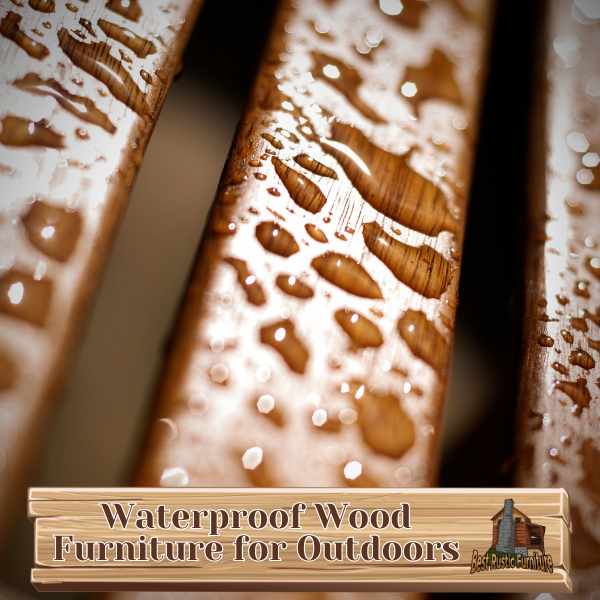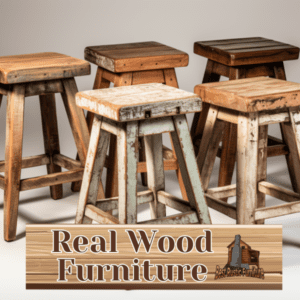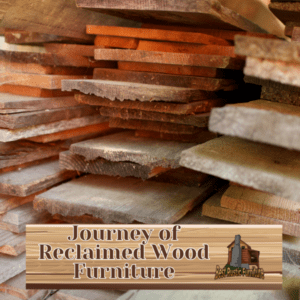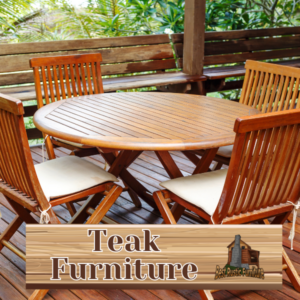
Wooden furniture can add natural beauty and warmth to your outdoor living space. However, exposure to moisture and weather elements can damage and deteriorate your furniture over time. To help you protect your outdoor wooden treasures, we have put together a comprehensive guide on how to effectively waterproof your wood furniture for outdoor use. By following these techniques, you can ensure durability and longevity for your favorite wooden pieces.
Key Takeaways
- Waterproofing your outdoor wood furniture is crucial for its longevity and durability.
- Choosing the right sealant method, preparing the wood surface, and selecting the appropriate finish are important steps to follow for effective waterproofing.
- Regular maintenance and taking additional measures, such as using furniture covers and placing the furniture in shaded areas, can enhance the durability of your waterproofed wood furniture.
Choosing the Right Sealant Method
When it comes to weatherproofing your outdoor furniture, selecting the right sealant method is crucial. The right sealant can protect your furniture from moisture, sunlight, and other outdoor elements, helping it to stand the test of time. One popular option is polyurethane varnish, a synthetic sealant that provides a durable and waterproof finish.
Other weatherproofing techniques include:
- Oil-based sealants
- Water repellent preservatives
- Waterproofing finishes
The choice of sealant method will depend on several factors, such as the type of wood, the level of exposure to the elements, and your personal preferences for the finished look. For example, some sealants may darken the wood, while others may have a glossy or matte finish.
Comparing Sealant Methods
To help you make an informed decision, we’ve created a comparison table outlining the pros and cons of some popular sealant methods:
| Sealant Method | Pros | Cons |
|---|---|---|
| Polyurethane varnish | Waterproof, durable, provides a glossy finish | May yellow over time with UV exposure, can be difficult to apply evenly |
| Oil-based sealants | Deeply penetrates the wood, enhances natural grain, easy to apply | May require frequent reapplication, not as durable as other options |
| Water repellent preservatives | Provides water resistance without altering the color or finish of the wood | May not be as effective as other methods, requires frequent reapplication |
| Waterproofing finishes | Durable and long-lasting, may provide a matte or satin finish | May darken the wood, can be difficult to apply evenly |
While each sealant method has its own advantages and disadvantages, the most important thing is to choose one that suits your needs and makes your outdoor furniture look its best. With the right sealant, your furniture can withstand the elements and stay beautiful for years to come.
Preparing the Wood Surface
Properly preparing the wood surface is crucial for effective waterproofing. Before applying any wood sealer, exterior wood must be sanded thoroughly to remove any rough spots and create a smooth surface that will absorb the sealer.
Start by using coarse-grit sandpaper to remove any finish or debris on the wood. Once the initial sanding is complete, switch to a finer-grit sandpaper and sand the wood once more for a smoother finish. Be sure to sand along the direction of the wood grain, as sanding against the grain can leave unsightly marks.
After sanding, it’s important to remove all dust and debris from the wood surface. Use a clean cloth or tack cloth to wipe the surface clean, ensuring there is no remaining sawdust or debris that could interfere with the application of the sealer.
Once the wood is sanded and cleaned, apply wood sealers to protect the wood against moisture, mold, and mildew. Choose a sealer that is appropriate for the type of wood you are using and follow the manufacturer’s instructions for application.
Types of Wood Sealers
| Sealer Type | Description |
|---|---|
| Oil-based Sealers | Protects the wood against moisture and UV damage, ideal for outdoor furniture. |
| Water-based Sealers | Environmentally friendly, dries quickly, and low odor suitable for indoor wood protection. |
| Epoxy Sealers | Provides a hard and durable finish, ideal for wooden decks and waterproofing wooden boats. |
Applying an exterior wood sealer regularly can extend the life of your outdoor wooden furniture and protect against weather damage. It is important to follow the recommended maintenance schedule and clean your furniture regularly to remove any dirt or debris that could damage the sealant.
Applying the Sealant
With the wood now prepped, it’s time to apply the sealant. One popular option is using oil-based sealants, which offer a durable and reliable solution for waterproofing wood furniture. These sealants penetrate deep into the wood and provide long-lasting protection against moisture and weathering.
Before applying the sealant, make sure the wood surface is clean and dry. To apply the sealant, use a brush or roller to evenly coat the surface. It’s best to apply several thin coats rather than one thick coat to ensure the sealant is absorbed and fully penetrates the wood.
It’s important to note that while sealants can protect against moisture, they do not prevent all types of damage. For example, UV rays from the sun can still fade and damage the wood, so it’s essential to also consider other protective measures like furniture covers or placing your furniture in shaded areas.
Applying the Sealant – Tips to Protect Wood
Here are some tips to keep in mind when applying sealants to help protect your wood furniture:
- Apply the sealant in a well-ventilated area
- Wear gloves and protective clothing
- Use a quality brush or roller for even application
- Allow each coat to dry completely before applying the next
- Sand lightly between each coat for a smooth finish
- Consider adding a clear coat on top of the sealant for added protection
By following these tips and applying the appropriate sealant, you can effectively waterproof your wood furniture and protect it from potential damage.
Choosing the Right Finish
When it comes to finishing your outdoor wood furniture after waterproofing, there are a variety of options to choose from. The right finish can not only enhance the natural beauty of the wood, but also provide additional protection against the elements.
Oil-Based Finish
An oil-based finish is a popular choice for outdoor wood furniture due to its ability to penetrate deep into the wood, providing long-lasting protection. It also enhances the natural color and grain of the wood, giving it a warm and rich appearance. However, oil-based finishes may require more maintenance and reapplication over time.
Polyurethane
Polyurethane is a hard, durable finish that provides excellent protection against scratches and water damage. It’s available in both oil- and water-based formulations, but oil-based polyurethane tends to provide better protection for outdoor use. Keep in mind that it may also darken the color of the wood.
Lacquer
Lacquer is a fast-drying and durable finish that provides excellent protection against moisture and common household chemicals. It also enhances the natural beauty of the wood by providing a clear and glossy appearance. However, it’s important to note that lacquer is not as durable as other finishes and may require more frequent maintenance.
Varnish
Varnish is a traditional and versatile finish that provides excellent protection against moisture and wear. It’s available in both oil- and water-based formulations, with oil-based varnish providing the best protection for outdoor use. However, it may require more maintenance over time and can be prone to cracking.
Consider the specific needs of your outdoor wood furniture when choosing a finish, and be sure to follow the manufacturer’s instructions for proper application and maintenance.
Understanding Wood Sealers and Stains
When it comes to waterproofing and enhancing the appearance of your wooden furniture, sealers and stains are the go-to solutions. With a variety of options available, it’s important to understand what they are and how they work to choose the best one for your needs.
Wood Sealers:
Wood sealers penetrate the wood surface to create a protective barrier against moisture, preventing swelling or shrinkage that can lead to cracks or warping. They are available in both clear and tinted varieties, with tinted sealers adding color and depth to the wood’s natural grain. When selecting a sealer, consider the type of wood you’re working with and the level of protection needed for the environment it will be placed in. Using lumber that has been kiln-dried or air-dried before applying the sealer can help achieve optimal results.
Stains:
Stains are another option for both waterproofing and enhancing the appearance of your wood furniture. Unlike sealers that create a protective layer, stains add color to the wood while allowing the natural grain to show through. They are available in a range of colors, from light to dark, and come in oil-based, water-based, and gel-based formulas. When selecting a stain, consider the natural color of the wood and the desired end result. It’s recommended to test a small, inconspicuous area before applying the stain to the entire piece.
Epoxy Sealers:
Epoxy sealers are a type of wood sealer that adds a layer of protection to the wood surface while also filling any cracks or imperfections. They are often used on outdoor wooden furniture due to their durability and resistance to harsh weather conditions. When applying epoxy sealers, it’s important to follow the manufacturer’s instructions carefully, as they often require mixing a resin and hardener in specific ratios for optimal results.
Paint as a Waterproofing Option
If you prefer a painted finish for your outdoor wood furniture, it’s important to choose the right type of paint and varnish to provide both waterproofing protection and aesthetic appeal.
Paint: When selecting paint for outdoor furniture, choose an exterior latex or oil-based paint. Oil-based paints offer better durability, but latex paints are easier to clean up and are less prone to yellowing.
Varnish: To protect the paint and provide a glossy finish, apply a clear varnish over the painted surface. Polyurethane varnish is a popular choice for outdoor furniture due to its strong resistance against weathering and UV rays.
Pro Tip: Avoid using indoor paint as it won’t hold up against the weather elements, and your furniture is likely to peel and crack.
Before painting, prepare the wood surface as you would with any other finish – by sanding it down and applying a suitable sealer.
Once painted, maintain the furniture by cleaning it with a mild soap and water solution regularly. If the paint chips or scratches, touch it up with a small brush to prevent water from seeping into the wood.
The Benefits of Tung Oil
If you’re looking for a natural and long-lasting way to waterproof your outdoor wood furniture, tung oil is an excellent option. This natural oil is extracted from the seeds of the tung tree and has been used for centuries to protect wooden surfaces, including boats, floors, and furniture.
One of the main benefits of tung oil is its ability to create a waterproof barrier while still allowing the wood to breathe. This means that moisture won’t seep into the wood, but the natural properties of the wood won’t be affected either.
Tung oil is also incredibly durable, making it a great choice for outdoor furniture that is exposed to the elements. It’s resistant to scratches, dents, and abrasions, so your furniture will look great for years to come.
| Advantages of Tung Oil | Disadvantages of Tung Oil |
|---|---|
| Creates a waterproof barrierAll-natural and non-toxicDurable and long-lasting | Takes longer to dry than other finishesCan darken the wood’s natural colorMay require multiple coats for optimal protection |
When using tung oil, it’s important to note that it takes longer to dry than other finishes. This means you’ll need to allow for additional drying time between coats and before using your furniture. Additionally, tung oil can darken the natural color of wood, so it’s important to test it on a small, inconspicuous area before applying it to the entire piece.
While tung oil is an excellent choice for waterproofing outdoor wood furniture, it may require multiple coats for optimal protection. However, the natural and long-lasting benefits make it a great investment for your outdoor wooden treasures.
Overall, using tung oil to waterproof your outdoor wood furniture is a great choice if you’re looking for a natural, non-toxic, and durable option. With proper application, tung oil can provide long-lasting protection while enhancing the natural beauty of your wooden furniture.
Section 9: Maintaining Waterproofed Wood Furniture
Congratulations, you have successfully waterproofed your wood furniture for outdoor use! However, proper maintenance and care are crucial to ensure your furniture remains protected and pristine. Here are some tips for maintaining your waterproofed furniture:
- Regular Cleaning: Dirt and grime can accumulate on your furniture and reduce its lifespan. Use a soft-bristled brush or cloth and a mild soap solution to clean your furniture regularly.
- Avoid Harsh Chemicals: Avoid using harsh chemicals such as bleach or ammonia, as they may damage the finish of your furniture.
- Reapply Sealant: Over time, the waterproofing sealant may wear off due to exposure to weather elements. Reapply the sealant every few years to maintain the protection of your furniture.
- Protect from Sun Exposure: Prolonged exposure to sunlight can damage the wood and finish of your furniture. Consider placing your furniture in a shaded area or using a furniture cover to protect it from UV rays.
- Avoid Water Stagnation: Avoid leaving water or other liquids to stagnate on your furniture, as they may damage the finish. Wipe away any spills or standing water immediately.
- Store Indoors During Winter: If you live in a cold climate, store your outdoor furniture indoors during the winter months to prevent exposure to extreme weather conditions.
By following these maintenance tips, you can ensure your waterproofed wood furniture remains in excellent condition for years to come.
Common Mistakes to Avoid
Waterproofing your wood furniture can be challenging, especially if you’re not familiar with the process. Here are some common mistakes to avoid:
- Skipping the sanding step: Properly preparing the wood surface is essential for an even application of the sealant. Skipping sanding can lead to an uneven finish and poor adherence of the sealant.
- Not using exterior wood: Using indoor wood for outdoor furniture can result in warping, cracking, and other types of damage. Make sure to use exterior wood types such as cedar, redwood, or pressure-treated lumber.
- Using the wrong sealant: Not all sealants are created equal. Some aren’t suitable for outdoor use, while others may not provide adequate water resistance. Choose a sealant that’s designed for outdoor wood furniture and offers waterproofing protection.
- Not applying enough sealant: Applying too little sealant can leave the wood vulnerable to water damage. Make sure to apply a generous amount of sealant and follow the manufacturer’s instructions for the best results.
- Not allowing enough drying time: Rushing the drying process can lead to sealant failure and a sticky or tacky finish. Allow the sealant to dry thoroughly between coats and before using the furniture.
By avoiding these common mistakes, you can ensure that your wood furniture is properly waterproofed and protected from the elements.
Enhancing Durability with Additional Measures
While proper waterproofing is crucial for outdoor wood furniture, additional measures can be taken to protect your pieces and enhance their durability. Here are some tips:
Furniture Covers
Investing in furniture covers is an excellent way to keep your outdoor wood furniture safe from the elements. These covers provide an extra layer of protection against rain, snow, and harsh sunlight, preventing damage and prolonging the lifespan of your pieces. Make sure to choose covers that fit your furniture snugly and are made from high-quality, waterproof materials.
Shaded Areas
Placing your outdoor wood furniture in shaded areas can also help to protect it from the damaging effects of sunlight and harsh weather. If your outdoor space does not have natural shade, consider using umbrellas, canopies, or other types of sun protection to shield your furniture.
Regular Maintenance
Even with proper waterproofing and additional measures, outdoor wood furniture still requires regular maintenance to ensure its longevity. This includes cleaning your pieces regularly, inspecting them for damage, and repairing any issues promptly. Applying a fresh coat of sealant every few years can also help to maintain their waterproofing properties.
Conclusion
By implementing these additional measures, you can further protect your outdoor wood furniture and ensure its durability for years to come. Remember to invest in high-quality furniture covers, consider shaded areas, and prioritize regular maintenance to keep your pieces looking their best.
Conclusion
Waterproofing your wood furniture for outdoor use is a great way to protect your investment and keep it looking great for years to come. By following the steps we’ve outlined in this article, including choosing the right sealant method, properly preparing the wood surface, and applying the sealant correctly, you’ll be able to effectively waterproof your outdoor wood furniture.
Don’t forget to select the appropriate finish for your furniture, whether it be oil-based, polyurethane, lacquer, or varnish. Additionally, regular maintenance and care, such as cleaning and storing your furniture in shaded areas, can help enhance its durability.
Remember, proper waterproofing is essential to protect your outdoor wood furniture from the damaging effects of moisture and weather. By following our guide, you’ll be able to enjoy your outdoor wooden treasures for many years to come.
Thank you for joining us!
FAQ
How do I waterproof wood furniture for outdoors?
To waterproof wood furniture for outdoor use, follow these steps: choose the right sealant method, prepare the wood surface, apply the sealant, choose the right finish, understand wood sealers and stains, consider paint as a waterproofing option, explore the benefits of tung oil, maintain waterproofed wood furniture, avoid common mistakes, enhance durability with additional measures.
What sealant method should I choose?
You can choose from various sealant methods such as polyurethane varnish and other weatherproofing techniques. It’s important to select the appropriate sealant method for your specific needs.
How do I prepare the wood surface?
Properly preparing the wood surface involves sanding the wood and applying wood sealers to ensure a smooth and even finish.
How do I apply the sealant?
Once the wood surface is prepared, you can apply the sealant using methods such as using oil-based sealants. It’s important to protect the wood from potential water damage.
What finish should I choose?
The choice of finish depends on your preferences. Options include oil-based, polyurethane, lacquer, and varnish finishes. Consider the desired level of protection and aesthetic appeal.
What are wood sealers and stains?
Wood sealers and stains are products that enhance the appearance of your furniture while providing waterproofing protection. There are different types available, including options like epoxy sealers for added durability.
Can I use paint to waterproof my furniture?
Yes, paint can be used as a waterproofing option. Properly using paint and varnish can provide both protection and aesthetic appeal to your outdoor wood furniture.
What are the benefits of using tung oil?
Tung oil is a popular choice for waterproofing outdoor wood furniture due to its natural and long-lasting properties. It provides excellent protection and enhances the natural beauty of the wood.
How do I maintain waterproofed wood furniture?
Regular maintenance is important to prolong the lifespan of your waterproofed furniture. This includes proper care and cleaning techniques to keep it looking its best.
What are some common mistakes to avoid when waterproofing wood furniture?
Common mistakes to avoid include improper sealant application, using the wrong sealant, neglecting regular maintenance, and not properly preparing the wood surface. Pay attention to these areas to achieve optimal results.
What additional measures can I take to enhance durability?
To enhance the durability of your waterproofed wood furniture, consider using furniture covers to protect it from the elements and placing your pieces in shaded areas to reduce exposure to direct sunlight.






